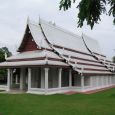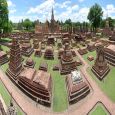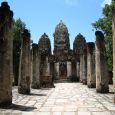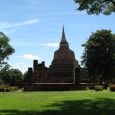Sukhothai
Advertisement
By plane
Bangkok Airways now has a daily flight from Bangkok Suvarnabhumi airport, which then continues on to Lampang. Fares from/to Bangkok start from THB 1700 (1 hour 20 minutes), from/to Lampang - from THB 1100 (around 40 minutes).
By train
Take the (express) train (7 hours from Bangkok or Chiang Mai) to Phitsanulok and go by bus from there (1 hour).
By bus
Sukothai only has a small bus station, but the city can be easily reached from the North, South, East and West.
From Mae Sot: Minibuses run regularly from the station behind the market. The journey takes about 3 hours, passing through Tak on the way. 130 baht.
From Phitsanulok: Frequent buses operate from the main bus terminal and take about 1 hour for the 58 km trip.
From Bangkok: There are direct buses from Bangkok Mochit Terminal and takes 7 hours, including some stops at Bus Terminal of major cities on the way. Understand that at the Terminal (Mo Chit), there are several bus companies travelling to a particular destination. In this instance, Wintour travel, as at November 2010, charges B326 per person for a first class aircon bus. It takes about 6 hours.
Advertisement
Old Sukhothai (Sukhothai Muang Kao)
Located 12 km to the west of today's Sukhothai, this was the capital of the Sukhothai Kingdom from 1238 to 1438 and contains many ruins from that period. Its importance has been internationally recognised and it is now a UNESCO World Heritage Site.
The old city is a popular tourist attraction, and the site has seen much restoration since the 1960s. It is well maintained, exceptionally clean and well furnished with vendors, though with only a minimum of touts. The heavy restoration is worth noting, since with some ruins and Buddha figures it can lead to a feeling that it is a little over-sanitised, especially in the central zone. The other zones are much less "restored" and trips down unmarked tracks can lead to ruins in their untouched state.
The best way to see the ruins in the Sukhotai National Historic Park is by bicycle. These can be rented from a shop opposite from the main park entrance. It is feasible to walk around the central and northern zones in 6 hours or so. There is also a 20 baht guided tour by electric tram available.
The Sukhothai Historical Park
The Sukhothai Historical Park covers the ruins of Sukhothai, capital of the Sukhothai kingdom in the 13th and 14th centuries,in what is now the north of Thailand. It is located near the modern city of Sukhothai, capital of the province with the same name.
The city walls form a rectangle about 2 km east-west by 1.6 km north-south. There are 193 ruins on 70 square kilometers of land.There is a gate in the centre of each wall. Inside are the remains of the royal palace and twenty-six temples, the largest being Wat Mahathat. The park is maintained by the Fine Arts Department of Thailand with help from UNESCO, which has declared it a World Heritage Site. The park sees thousands of visitors each year, who marvel at the ancient Buddha figures, palace buildings and ruined temples. The park is easily toured by bicycle or even on foot.
Sukhothai
Sukhothai story was narrated into Thailand's "national history" in late nineteenth century by King Mongkut, Rama IV, as a historical work presented to the British diplomatic mission. King Mongkut is considered as the champion of Sukhothai narrative history, based on his found of the Number One Stone Inscription, the 'first evidence' telling the history of Sukhothai.From then on, as a part of modern nation building process, modern national Siamese or Thai history comprises the history of Sukhothai. Sukhothai was said to be the 'first national capital', followed by Ayutthaya, Thonburi until Rattanakosin or today Bangkok. Sukhothai history was crucial among Siam/ Thailand's 'modernists', both 'conservative' and 'revolutionary'. Rama IV or King Mongkut, was said he found 'the first Stone Inscription' in Sukhothai, telling story of Sukhothai's origin, heroic kings such as Ramkhamhaeng, administrative system and other developments, considered as the 'prosperous time' of the kingdom.
Information not available
Information not available
Advertisement







